
Pinus parviflora, also known as five-needle pine, or Japanese white pine, is a pine in the white pine group, Pinus subgenus Strobus, native to Japan.

Ornamental grasses are grasses grown as ornamental plants. Ornamental grasses are popular in many colder hardiness zones for their resilience to cold temperatures and aesthetic value throughout fall and winter seasons.

Iberis sempervirens, the evergreen candytuft or perennial candytuft, is a species of flowering plant in the family Brassicaceae, native to southern Europe. The species is often used as an ornamental garden shrub because of its decorative flowers. Iberis is so named because many members of the genus come from the Iberian Peninsula in south west Europe. Sempervirens means "always green", referring to the evergreen foliage.

Phlox subulata the creeping phlox, moss phlox, moss pink or mountain phlox, is a species of flowering plant in the family Polemoniaceae, native to eastern and central USA, and widely cultivated.

Phlomis fruticosa, the Jerusalem sage, is a species of flowering plant in the family Lamiaceae, native to Albania, Cyprus, Greece, Italy, Turkey, and countries of the former Yugoslavia.

Teucrium fruticans is a species of flowering plant in the mint family Lamiaceae, native to the western and central Mediterranean. Growing to 1 m (3 ft) tall by 4 m (13 ft) wide, it is a spreading evergreen shrub with arching velvety white shoots, glossy aromatic leaves and pale blue flowers in summer.
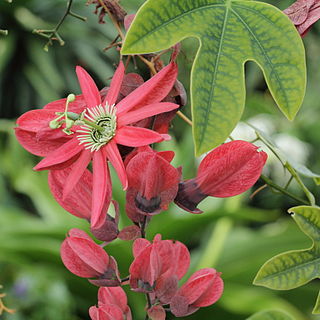
Passiflora racemosa, the red passion flower, is a species of flowering plant in the family Passifloraceae, native to Brazil. It is an evergreen climber growing to 5 m (16 ft), with simple or 3-lobed leaves to 10 cm (4 in) long, and vivid red flowers borne in summer. The flowers are 12 cm (5 in) in diameter, with purple and white coronas. They are followed by oblong green fruits.

Geranium subcaulescens is a species of flowering plant in the geranium family Geraniaceae, that is native to Italy, Turkey and the Balkans. A low, mounded evergreen perennial, it typically grows to 8 in (20 cm) tall by more than 11 in (28 cm) broad, with grey-green orbicular and lobed leaves, and masses of bright magenta pink flowers with black centres in summer.
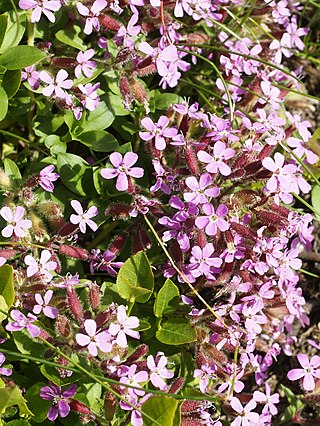
Saponaria ocymoides, the rock soapwort or tumbling Ted, is a species of semi-evergreen perennial flowering plant belonging to the family Caryophyllaceae, native to south western and southern central Europe.
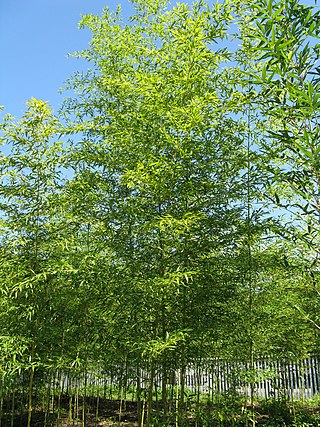
Semiarundinaria fastuosa, the Narihira bamboo, Narihira cane or Narihiradake, is a species of flowering plant in the grass family Poaceae, native to Japan. Growing to 7 m (23 ft) tall by 2 m (7 ft) broad, it is a vigorous, evergreen bamboo with dark green cylindrical canes and dense tufts of lanceolate, glossy green leaves, up to 20 cm (8 in) long.
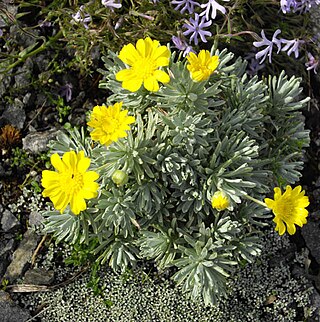
Euryops acraeus, the mountain euryops, is a species of flowering plant in the daisy family Asteraceae, native to the Drakensberg Mountains of South Africa. It is a dwarf, rounded evergreen shrub growing to 30 cm (12 in) tall and wide, with silver-blue leaves and masses of yellow composite flowers in spring and summer.

Gentiana sino-ornata, the showy Chinese gentian, is a species of flowering plant in the family Gentianaceae, native to western China and Tibet. It is a low-growing semi-evergreen perennial growing to 5–7 cm (2–3 in) tall, with multiple prostrate stems 15–30 cm (6–12 in) long, bearing single trumpet-shaped flowers of a pure blue with a white- and green-striped throat, in autumn.

Globularia cordifolia, the heart-leaved globe daisy, is a species of flowering plant in the family Plantaginaceae, native to the mountains of central and southern Europe, and western Turkey.

Helleborus argutifolius, the holly-leaved hellebore, or Corsican hellebore, syn. H. corsicus, H. lividus subsp. corsicus is a species of flowering plant in the family Ranunculaceae, native to Corsica and Sardinia. It is an evergreen perennial growing to 120 cm (47 in) tall by 90 cm (3 ft) wide, with large leathery leaves comprising three spiny-toothed leaflets, and green bowl-shaped flowers in late winter and early spring.

Linum flavum, the golden flax or yellow flax, is a species of flowering plant in the family Linaceae, native to central and southern Europe. It is an erect, woody perennial growing to 30 cm (12 in) tall by 20 cm (8 in) broad, with dark green, semi-evergreen leaves, and terminal clusters of bright yellow, five-petalled flowers in spring. The Latin flavum means "pure yellow".
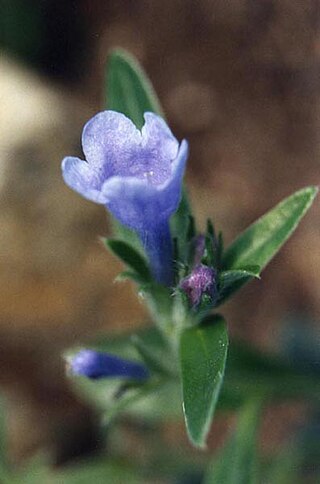
Glandora oleifolia(Lapeyr.) D.C.Thomas, the olive-leaved gromwell, is a species of flowering plant in the family Boraginaceae. The plant is native to a small rocky area near Figueras in the eastern Pyrenees, and is endemic to Spain.

Polygala calcarea, the chalk milkwort, is a species of flowering plant in the family Polygalaceae, native to western Europe. It is a delicate mat-forming evergreen perennial growing to 5 cm (2 in) tall by 20 cm (8 in) broad, with spikes of small, vivid deep blue flowers in spring, and leathery, oval leaves.
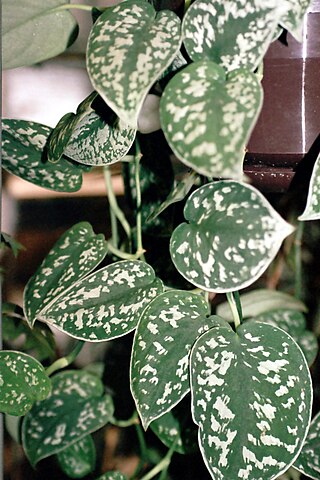
Scindapsus pictus, or silver vine, is a species of flowering plant in the arum family Araceae, native to India, Bangladesh, Thailand, Peninsular Malaysia, Borneo, Java, Sumatra, Sulawesi, and the Philippines.

Nerine undulata syn. N. crispa is a species of flowering plant in the subfamily Amaryllidoideae of the family Amaryllidaceae, that is native to the eastern Cape of South Africa. Growing to 45 cm (18 in) tall, it is a bulbous perennial with narrow grasslike leaves that are almost evergreen, and umbels of 8-12 slender, crinkled pale pink or mid-pink flowers 5 cm across in autumn.

Phyllostachys vivax, the Chinese timber bamboo, is a species of flowering plant in the bamboo subfamily of the grass family Poaceae, native to China.




















